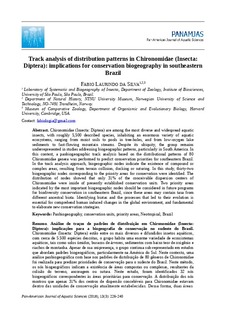Track analysis of distribution patterns in Chironomidae (Insecta:Diptera): implications for conservation biogeography in southeastern Brazil
Journal article, Peer reviewed
Published version

Åpne
Permanent lenke
http://hdl.handle.net/11250/2594422Utgivelsesdato
2018Metadata
Vis full innførselSamlinger
- Institutt for naturhistorie [1218]
- Publikasjoner fra CRIStin - NTNU [37703]
Originalversjon
Pan-American Journal of Aquatic Sciences. 2018, 13 (3), 226-240.Sammendrag
Chironomidae (Insecta: Diptera) are among the most diverse and widespread aquatic insects, with roughly 5,500 described species, inhabiting an enormous variety of aquatic ecosystems, ranging from moist soils to pools in tree-holes, and from low-oxygen lake sediments to fast-flowing mountain streams. Despite its ubiquity, the group remains underrepresented in studies addressing biogeographic patterns, particularly in South America. In this context, a panbiogeographic track analysis based on the distributional patterns of 80 Chironomidae genera was performed to predict conservation priorities for southeastern Brazil. In the track analysis approach, biogeographic nodes indicate the existence of compound or complex areas, resulting from terrain collision, docking or suturing. In this study, thirty-two biogeographic nodes corresponding to the priority areas for conservation were identified. The distribution of nodes showed that only 31% of the conceivable dispersion centers of Chironomidae were inside of presently established conservation units. Two priority areas indicated by the most important biogeographic nodes should be considered in future programs for biodiversity conservation in southeastern Brazil, since these areas may contain taxa from different ancestral biota. Identifying biotas and the processes that led to their evolution is essential for comprehend human induced changes in the global environment, and fundamental to elaborate new conservation strategies.